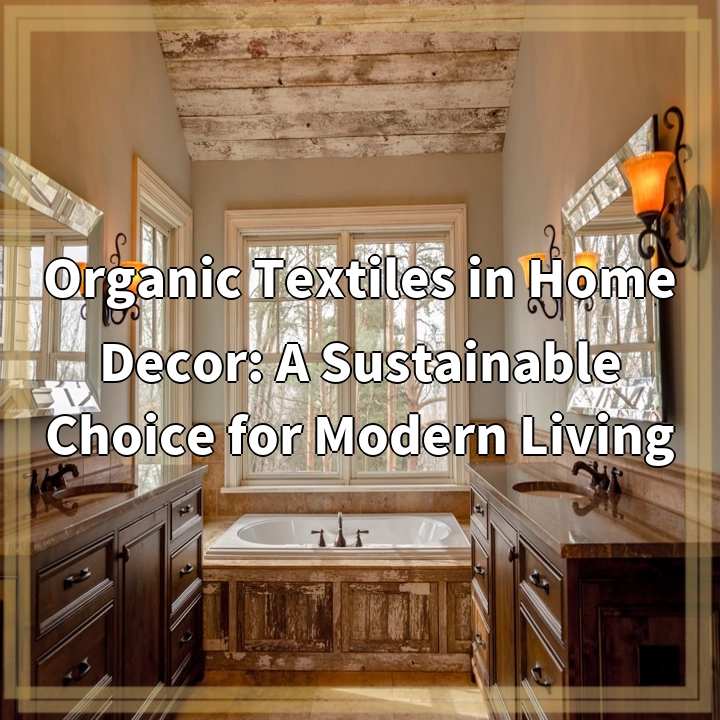
What it is:
Organic textiles refer to fabrics made from natural fibers that are grown without the use of synthetic pesticides, herbicides, or genetically modified organisms (GMOs). In home decor, these materials are increasingly popular due to their sustainability and eco-friendliness. Common organic textiles include cotton, linen, hemp, and wool, all of which are cultivated using organic farming practices that prioritize soil health, biodiversity, and water conservation.
Organic textiles in home decor are not only beneficial for the environment but also contribute to healthier indoor air quality. Without the use of harmful chemicals, organic fabrics are less likely to emit volatile organic compounds (VOCs), making them a safer choice for home furnishings such as curtains, upholstery, bedding, and rugs. This shift towards organic materials represents a growing awareness among consumers about the impact of their purchasing choices on both the environment and personal health.
Real-world problems:
Despite the numerous benefits of organic textiles, there are several real-world problems associated with their production and use. One significant challenge is the higher cost of organic materials compared to conventional textiles. The organic farming process is often more labor-intensive, and the yield can be lower, leading to increased prices. This makes organic textiles less accessible for budget-conscious consumers.
Another issue is the prevalence of greenwashing within the textile industry. Some companies may market their products as “organic” without adhering to genuine organic practices. This can lead to consumer confusion and skepticism about the true sustainability of certain textiles. To combat this, it’s essential for consumers to research brands and look for certifications that verify organic claims, such as GOTS (Global Organic Textile Standard) or OEKO-TEX.
Additionally, while organic textiles are often touted as a sustainable alternative, the environmental impact of cotton farming, even when organic, can still be significant due to water usage and land degradation. The heavy water consumption required for cotton cultivation can strain local water resources, posing a challenge for sustainable agricultural practices.
Lastly, the limited availability of organic fibers can also present challenges. In certain regions, the supply of organic textiles may be restricted, leading to a reliance on imported materials. This not only increases the carbon footprint associated with transporting these products but can also limit the variety of organic home decor options for consumers.

Solutions for Promoting Organic Textiles in Home Decor
To address the challenges associated with organic textiles in home decor, several solutions can be implemented that promote sustainability while enhancing accessibility for consumers.
1. Educating Consumers
Raising awareness about the benefits of organic textiles is crucial. Brands and organizations can invest in educational campaigns that inform consumers about the advantages of choosing organic materials, including their lower environmental impact and health benefits. This knowledge can empower consumers to make informed decisions and foster a demand for sustainable options.
2. Encouraging Transparent Practices
Transparency in the textile supply chain is essential to combat greenwashing. Brands should clearly communicate their sourcing practices, certifications, and the steps they take to ensure genuine organic production. By fostering transparency, consumers can make more informed choices and support companies that adhere to ethical practices.
3. Supporting Local and Sustainable Farmers
Encouraging the use of locally sourced organic materials can help mitigate the environmental impacts related to transportation and promote the local economy. Supporting small-scale farmers who practice sustainable agriculture can also lead to more diverse organic textile options for consumers.
4. Advocating for Sustainable Practices in Cotton Farming
To address water consumption issues in cotton farming, advocating for and investing in advanced agricultural practices that reduce water usage can be beneficial. Techniques such as rainwater harvesting, drip irrigation, and crop rotation can enhance the sustainability of organic cotton farming and minimize environmental impacts.
5. Expanding the Range of Organic Textiles
Encouraging innovation in the market to offer a broader range of organic textiles, including alternative fibers like hemp, bamboo, and recycled materials, can address the limitations of current offerings. By diversifying the availability of organic fabrics, consumers will have more choices, making it easier to incorporate sustainability into their home decor.
6. Building Community and Collaboration
Creating networks for designers, manufacturers, and consumers can facilitate collaboration and knowledge sharing in the organic textiles sector. By working together, stakeholders can identify solutions to common challenges, improve supply chains, and promote sustainable practices within the home decor industry.















